
Atriplex is a plant genus of about 250 species, known by the common names of saltbush and orache. It belongs to the subfamily Chenopodioideae of the family Amaranthaceae s.l.. The genus is quite variable and widely distributed. It includes many desert and seashore plants and halophytes, as well as plants of moist environments. The generic name originated in Latin and was applied by Pliny the Elder to the edible oraches. The name saltbush derives from the fact that the plants retain salt in their leaves; they are able to grow in areas affected by soil salination.

Baccharis pilularis, called coyote brush, chaparral broom, and bush baccharis, is a shrub in the family Asteraceae native to California, Oregon, Washington, and Baja California. There are reports of isolated populations in New Mexico, most likely introduced.
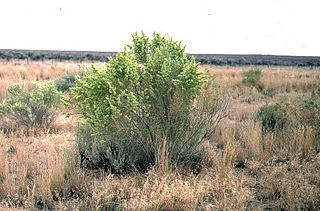
Atriplex canescens is a species of evergreen shrub in the family Amaranthaceae native to the western and midwestern United States.
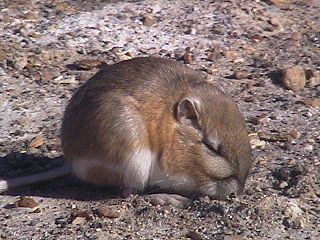
The chisel-toothed kangaroo rat is a species of rodent in the family Heteromyidae.
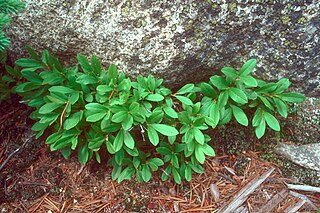
Vaccinium cespitosum, known as the dwarf bilberry, dwarf blueberry, or dwarf huckleberry, is a species of flowering shrub in the genus Vaccinium, which includes blueberries, huckleberries, and cranberries.

Atriplex hymenelytra, the desert holly, is silvery-whitish-gray shrub in the family Amaranthaceae, native to deserts of the southwestern United States. It is the most drought tolerant saltbush in North America. It can tolerate the hottest and driest sites in Death Valley, and remains active most of the year.
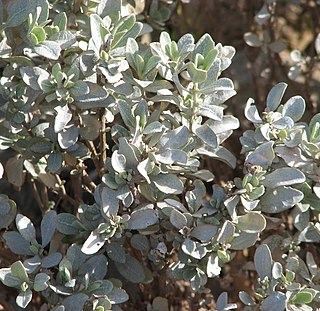
Atriplex vesicaria, commonly known as bladder saltbush, is a species of flowering plant of the family Amaranthaceae and is endemic to arid and semi-arid inland regions of Australia. It is an upright or sprawling shrub with scaly leaves and separate male and female plants, the fruit often with a bladder-like appendage.

Atriplex argentea is a species of saltbush known by the common names silverscale saltbush and silver orache. It is native to western North America from southern Canada to northern Mexico, where it grows in many types of habitat, generally on saline soils.
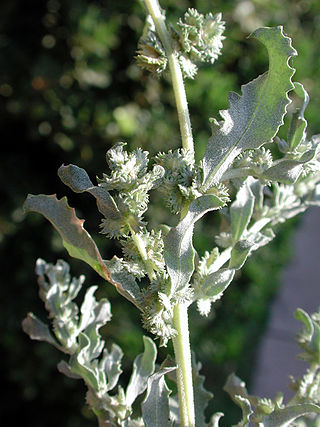
Atriplex elegans is a species of saltbush known by the common name wheelscale saltbush, Mecca orach, or wheelscale. It is native to the Southwestern United States, and northern Mexico, where it grows in areas of saline or alkaline soils, such as alkali flats and desert dry lakebeds.

Atriplex lentiformis is a species of saltbush.
Atriplex parishii is an uncommon species of saltbush known by the common names Parish's saltbush and Parish's brittlescale. It is native to central and southern California where it can occasionally be found along the immediate coastline, and the Channel Islands. Its distribution extended historically into the western edges of the Mojave Desert and Baja California and it may still exist there.

Calochortus excavatus is a species of flowering plant in the lily family known by the common name Inyo County star-tulip.
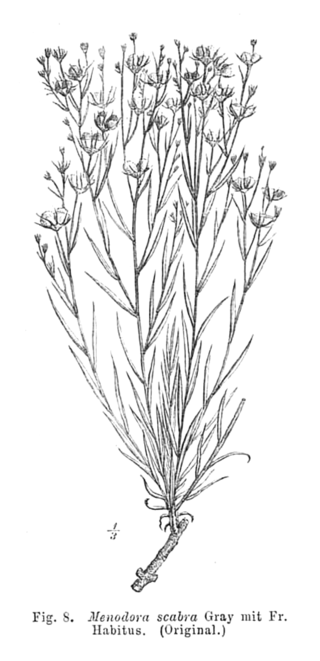
Menodora scabra is broom-like shrub in the Olive Family (Oleaceae), known by the common name rough menodora or broom twinberry. It is a popular desert garden plant.

Atriplex gardneri is a species of flowering plant in the amaranth family known by the common name Gardner's saltbush. It is native to western North America from British Columbia to Saskatchewan in Canada south to Nevada and New Mexico in the United States. The specific epithet of the species, gardneri, is misnamed after its first collector, Alexander Gordon. The naturalist Alfred Moquin-Tandon was under the impression that Gordon's last name was Gardner.

Ericameria paniculata is a species of flowering plant in the sunflower family Asteraceae, native to the southwestern United States. It is an evergreen yellow-flowered desert shrub.
Atriplex acanthocarpa is a species of flowering plant in the amaranth family known by the common names armed saltbush, tubercled saltbush, and huaha. It is native to North America, where it is limited to the US states of Arizona, New Mexico, and Texas, and adjacent Mexico.

Atriplex nuttallii, also known as Nuttall's saltbush, is native to central and western North America. It has been treated by some botanists as a synonym of Atriplex canescens.

Ambrosia salsola, commonly called cheesebush, winged ragweed, burrobush, white burrobrush, and desert pearl, is a species of perennial shrub in the family Asteraceae native to deserts of the southwestern United States and northwestern Mexico.
Saltbush scrub is a Mojave Desert plant community and vegetation type, found above and beyond the alkali sink Shadscale scrub type.
Shadscale scrub is a plant community and vegetation type that occurs in upper elevations of the Mojave Desert and lower elevations of the Great Basin ecoregion or biome, characterized by salt tolerant plants—halophytes.

















